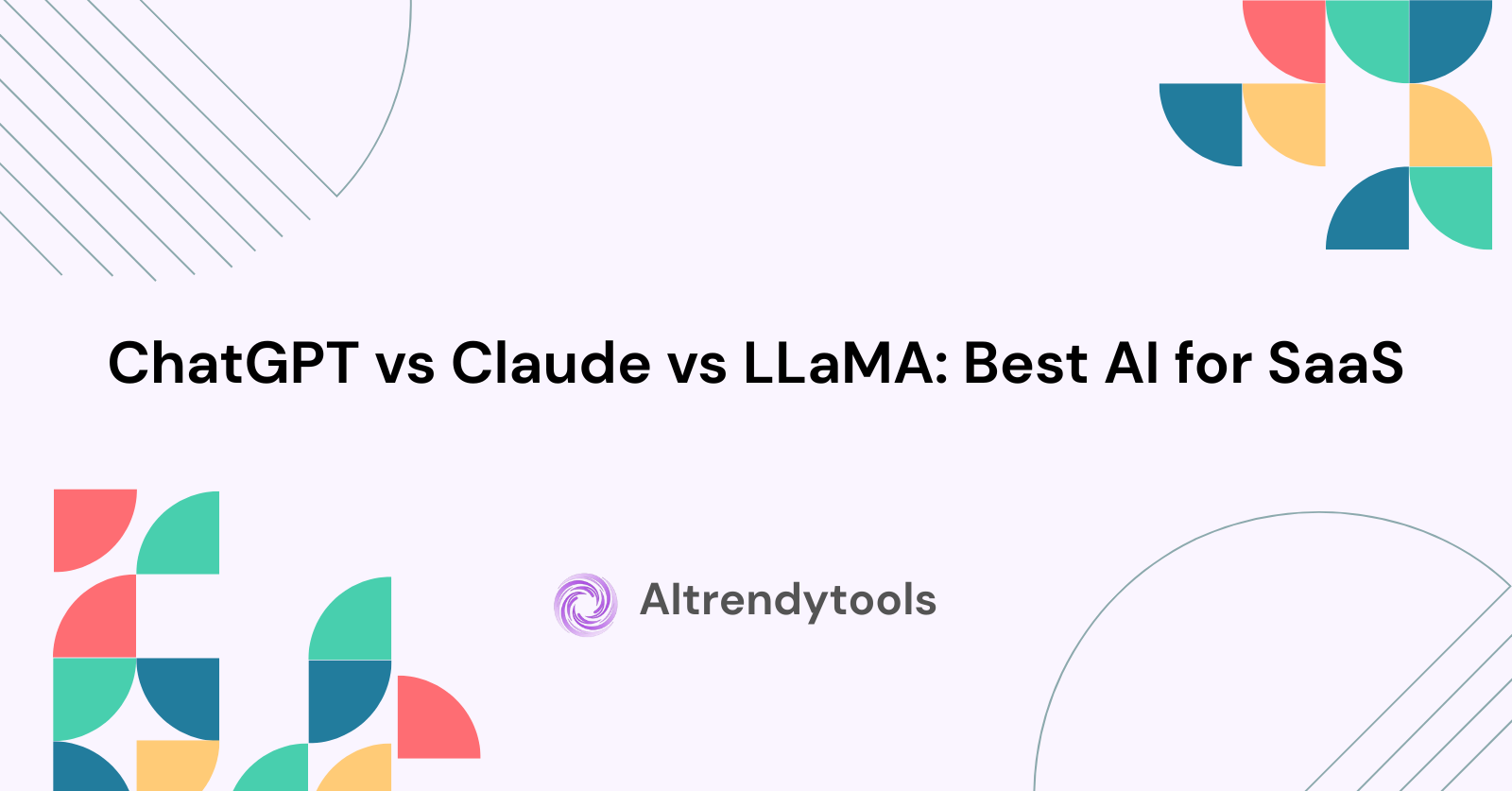🔥 AITrendytools: The Fastest-Growing AI Platform |
Write for usChatGPT vs Claude vs LLaMA: Best AI for SaaS
Compare ChatGPT, Claude & LLaMA for SaaS. Pricing, features, use cases & integration guide. Choose the right AI model for your application
Oct 27, 2025
Choosing the right AI model determines your SaaS application's success. ChatGPT, Claude, and LLaMA each offer unique advantages for different business needs. Your decision impacts user experience, operational costs, and competitive positioning.
The AI landscape moves fast. What worked six months ago might not be optimal today. This guide examines each platform's strengths, weaknesses, and ideal use cases to help you make an informed decision.
Understanding AI Models for SaaS Applications
Large language models transform how users interact with software. These AI systems process natural language and generate human-like responses. Modern SaaS companies integrate them into customer support, content creation, data analysis, and workflow automation.
Core capabilities all three models share:
- Natural language understanding and generation
- Multi-language support
- Context retention across conversations
- API accessibility for integration
- Customization through prompt engineering
The right model depends on your specific requirements. Budget constraints matter as much as technical capabilities.
ChatGPT API Integration for SaaS Products
OpenAI's ChatGPT leads the conversational AI market. Millions of users interact with ChatGPT daily. The model comes in multiple versions, with GPT-4 being the most advanced option.
ChatGPT Capabilities and Features
GPT-4 handles complex reasoning tasks with impressive accuracy. The model maintains context across lengthy conversations. It generates code, analyzes documents, and creates content in dozens of languages.
Key ChatGPT strengths:
- Exceptional creative writing abilities
- Strong multi-turn conversation handling
- Extensive knowledge base across diverse topics
- Function calling for external tool integration
- Image understanding (GPT-4V)
- JSON mode for structured outputs
The model switches between formal and casual tones seamlessly. It follows detailed instructions while maintaining output consistency. Function calling enables your SaaS app to trigger specific actions based on user requests.
ChatGPT Pricing Structure
OpenAI charges based on token consumption. Input tokens cost less than output tokens. Understanding this pricing model helps you budget effectively.
Model
Input (per 1K tokens)
Output (per 1K tokens)
Best For
GPT-4
$0.03
$0.06
Complex reasoning
GPT-4-turbo
$0.01
$0.03
Balanced performance
GPT-3.5-turbo
$0.0015
$0.002
High-volume tasks
Volume discounts become available for enterprise customers. Estimating monthly token consumption prevents budget surprises. Unexpected viral growth can generate substantial bills quickly.
Best Use Cases for ChatGPT
Customer support chatbots leverage ChatGPT's conversational abilities. The model handles diverse queries without extensive training. It maintains helpful responses even when users phrase questions poorly.
Ideal ChatGPT applications:
- Customer service automation
- Content generation tools
- Code completion and debugging
- Email and document drafting
- Creative writing assistance
- Educational tutoring systems
Content creation tools benefit from ChatGPT's creative capabilities. Marketing copy, product descriptions, and blog posts flow naturally. The model adapts to different brand voices with proper prompting.
ChatGPT Limitations to Consider
Rate limits can throttle high-volume applications. OpenAI implements strict usage caps during peak times. Your SaaS might experience slowdowns when demand spikes.
Challenges to plan for:
- Occasional hallucinations and incorrect information
- Privacy concerns with third-party data processing
- Rate limiting during traffic peaks
- Dependency on OpenAI's infrastructure
- Limited customization without fine-tuning
- Knowledge cutoff limitations
The model sometimes generates confident but incorrect information. Fact-checking becomes necessary for critical applications. Privacy concerns arise when sending sensitive customer data to external servers.
Claude AI Capabilities for Enterprise Solutions
Anthropic's Claude offers a thoughtful alternative to ChatGPT. The model prioritizes safety and accuracy in responses. Enterprise teams appreciate Claude's analytical depth and nuanced outputs.
Claude's Unique Strengths
Claude excels at analytical tasks requiring careful reasoning. The model breaks down complex problems methodically. It provides well-structured responses with clear logical flow.
What sets Claude apart:
- Extended context windows (200K+ tokens)
- Superior analytical reasoning
- Strong ethical guardrails
- Excellent code generation quality
- Honest about knowledge limitations
- Better refusal of inappropriate requests
Long context windows let Claude process entire codebases. You can feed it lengthy reports or comprehensive documentation. The model maintains coherence across these extensive inputs.
Claude Pricing and API Access
Anthropic offers multiple Claude versions at different price points. Claude Sonnet balances cost and capability effectively. Opus provides maximum intelligence for demanding tasks.
Model
Input (per 1K tokens)
Output (per 1K tokens)
Context Window
Claude Opus
$0.015
$0.075
200K tokens
Claude Sonnet
$0.003
$0.015
200K tokens
Claude Haiku
$0.00025
$0.00125
200K tokens
API access requires an application process. Anthropic vets potential customers before granting access. This ensures the platform serves legitimate business needs.
Claude Performance Benchmarks
Claude performs exceptionally well on coding tasks. The model generates cleaner, more maintainable code. It catches potential bugs and security issues proactively.
Areas where Claude leads:
- Long document analysis
- Complex reasoning tasks
- Mathematical problem solving
- Ethical decision making
- Code quality and security
- Detailed explanations
Writing quality surpasses many competitors on subjective measures. Claude produces natural-sounding prose with consistent tone. Mathematical reasoning shows strong results in standardized tests.
Integration Options for Claude
RESTful API endpoints simplify Claude integration. Standard HTTP requests handle all interactions. Your development team won't face a steep learning curve.
SDKs for Python, TypeScript, and other languages speed development. Comprehensive documentation covers common use cases. Streaming responses improve user experience for real-time applications.
LLaMA Deployment Options and Flexibility
Meta's LLaMA represents the open-source alternative. You download and run the model on your infrastructure. This approach grants maximum control and customization possibilities.
LLaMA 2 Technical Specifications
LLaMA 2 comes in multiple sizes from 7B to 70B parameters. Larger models deliver better performance but require more computing resources. The 13B version strikes a good balance for many applications.
LLaMA 2 model variants:
- 7B parameters: Runs on single GPU, fastest inference
- 13B parameters: Better quality, moderate resources
- 70B parameters: Highest quality, requires multiple GPUs
The model supports fine-tuning on custom datasets. You can specialize LLaMA for your specific domain. This improves accuracy for industry-specific terminology and tasks.
Commercial licensing allows business use without restrictions. Meta removed many limitations from the original LLaMA release.
Self-Hosting AI Models
Running LLaMA on your servers eliminates per-token costs. Your expenses become predictable regardless of usage volume. This makes financial planning much simpler.
Infrastructure requirements:
- GPU with 16GB+ VRAM for 7B model
- Multiple GPUs or 80GB VRAM for 70B model
- Fast storage for model weights (50GB+)
- Adequate CPU and RAM for preprocessing
- Load balancing for production traffic
Infrastructure management becomes your responsibility. You'll handle scaling, monitoring, and maintenance. DevOps expertise is essential for reliable deployment.
Cost Benefits of Open Source AI
LLaMA eliminates ongoing API fees entirely. You only pay for compute infrastructure and electricity. High-volume applications see massive savings compared to API-based solutions.
Usage Level
ChatGPT Monthly Cost
Claude Monthly Cost
LLaMA Monthly Cost
1M tokens
$30-60
$15-75
$500 (GPU rental)
10M tokens
$300-600
$150-750
$500 (same GPU)
100M tokens
$3,000-6,000
$1,500-7,500
$500-1,500
No data leaves your network with self-hosted models. This solves many privacy and compliance concerns. Financial and healthcare SaaS companies particularly value this control.
LLaMA Performance Trade-offs
Raw capability often trails GPT-4 and Claude in standardized benchmarks. The gap narrows with proper fine-tuning and optimization. For many tasks, LLaMA performs adequately after customization.
Trade-offs to consider:
- Lower baseline performance than commercial models
- Requires technical expertise to deploy
- Ongoing maintenance overhead
- Hardware upgrade responsibilities
- Limited official support channels
Response latency depends heavily on your hardware setup. Cloud-based APIs typically respond faster initially. Optimization and caching can close this performance gap.
AI Model Performance Comparison
Objective metrics help cut through marketing claims. Real-world testing reveals meaningful differences. Let's examine how these models stack up across key dimensions.
Natural Language Understanding Tests
All three models handle basic comprehension excellently. They parse user intent accurately in straightforward scenarios. Differences emerge with ambiguous or complex inputs.
Performance on standard benchmarks:
Benchmark
ChatGPT (GPT-4)
Claude (Opus)
LLaMA 2 (70B)
MMLU
86.4%
86.8%
68.9%
HumanEval (Coding)
67.0%
84.9%
29.9%
GSM8K (Math)
92.0%
95.0%
56.8%
Claude shows slight advantages in nuanced language understanding. The model picks up on subtle contextual clues better. It handles sarcasm and implied meaning more reliably.
ChatGPT processes colloquial language and slang effectively. Its training data includes diverse internet text. This helps with casual customer interactions and modern communication styles.
Code Generation Quality
ChatGPT generates functional code quickly across many programming languages. The output usually runs correctly with minor adjustments. It excels at boilerplate and common coding patterns.
Code quality factors:
- Correctness and bug-free execution
- Readability and maintainability
- Security best practices
- Proper error handling
- Documentation quality
Claude produces more thoughtful code architecture. The model considers edge cases and potential issues proactively. Comments and documentation quality exceed other options consistently.
LLaMA handles standard coding tasks competently. Custom training on your codebase improves results significantly. The model learns your team's conventions and preferred styles.
Response Accuracy Metrics
Factual accuracy remains challenging for all large language models. None achieve perfect reliability on knowledge-based questions. Hallucinations occur across the board with varying frequency.
Claude tends to express uncertainty more appropriately. The model qualifies statements when confidence is low. This reduces the spread of incorrect information to users.
AI Model Scalability for Growing SaaS
Your chosen AI model must grow with your business. Early success leads to increased usage quickly. Scalability challenges can blindside unprepared teams if not planned properly.
Handling Traffic Spikes
API-based solutions scale automatically to handle demand. OpenAI and Anthropic manage infrastructure complexity behind the scenes. Your application stays responsive during viral moments.
Scaling considerations:
- Rate limits during extreme traffic spikes
- Geographic distribution of API endpoints
- Fallback strategies for service interruptions
- Queue management for high-volume periods
- Cost monitoring and budget alerts
Self-hosted LLaMA requires capacity planning ahead of time. You need surplus GPU resources to handle traffic peaks. Auto-scaling groups can help but add operational complexity.
Cost Scaling Considerations
Token-based pricing grows linearly with usage volume. A 10x increase in users means roughly 10x higher costs. This remains manageable with predictable, steady growth.
Cost optimization strategies:
- Implement response caching for common queries
- Use cheaper models for simple tasks
- Compress prompts to reduce token usage
- Set up spending alerts and limits
- Monitor cost per successful interaction
Unexpected viral success can generate enormous bills quickly. Cost controls and monitoring become critical safeguards. Setting spending limits prevents budget disasters and unexpected overages.
Global Deployment Strategies
Multi-region deployments reduce latency for international users. API providers offer endpoints in major geographic regions. Your application routes requests to nearby servers automatically.
Self-hosted solutions require infrastructure in each target region. This multiplies complexity and operational overhead significantly. Cloud providers' global networks simplify this deployment somewhat.
Security and Privacy Considerations
AI models handle sensitive user data regularly. Security practices must match your risk profile and industry requirements. Different models present unique security challenges and opportunities.
Data Privacy with Cloud AI APIs
Cloud-based models process your data on external servers. This creates potential privacy vulnerabilities that need addressing. Understanding data handling policies is crucial for compliance.
Privacy protections with API providers:
- Data is not used for model training
- Enterprise agreements with additional safeguards
- Compliance certifications (SOC 2, ISO)
- Data retention policies
- Geographic data processing options
OpenAI's terms specify they don't train on API data. Your inputs remain separate from model improvement processes. Anthropic follows similar privacy practices with Claude deployments.
Self-Hosted Model Security
Running LLaMA on-premises keeps data within your infrastructure. No information crosses into third-party systems externally. This provides maximum privacy control and data sovereignty.
Self-hosting security responsibilities:
- Securing model weights and parameters
- Protecting fine-tuned versions
- Implementing API authentication
- Rate limiting and abuse prevention
- Input validation and sanitization
- Monitoring for anomalous usage
You become responsible for securing the model infrastructure. Model weights and fine-tuned versions need protection from unauthorized access. Standard API security measures remain necessary regardless.
Compliance and Regulatory Requirements
GDPR imposes strict data handling requirements in Europe. Sending EU citizen data to US servers needs careful consideration. Standard contractual clauses help but add legal complexity.
Regulation
ChatGPT/Claude
LLaMA Self-Hosted
GDPR
Possible with DPA
Full control
HIPAA
Limited options
Ideal solution
SOC 2
Provider certified
Your responsibility
PCI DSS
Complex setup
Complete control
HIPAA compliance for healthcare SaaS essentially requires self-hosting. API providers don't typically sign Business Associate Agreements. LLaMA becomes the practical choice for medical applications.
Integration and Development Experience
Developer experience affects time-to-market and ongoing maintenance costs. Easy integration accelerates your product development timeline. Poor documentation creates frustrating delays and technical debt.
API Documentation Quality
OpenAI provides extensive documentation with numerous practical examples. Interactive playgrounds let you test prompts immediately without coding. The community has created countless tutorials and guides online.
Documentation quality factors:
- Clarity and completeness
- Code examples in multiple languages
- Interactive testing tools
- Troubleshooting guides
- Community resources
Anthropic's documentation is clear and well-organized throughout. Code samples cover common integration patterns effectively. The smaller community means fewer third-party resources currently available.
LLaMA relies on open-source community documentation efforts. Quality varies significantly across different implementations and frameworks. Official Meta documentation covers basics but lacks depth in places.
SDK and Library Support
ChatGPT offers official SDKs for major programming languages. Python and JavaScript libraries work excellently out of the box. Community-maintained options exist for niche languages and frameworks.
Claude provides similar official SDK support across platforms. The libraries mirror OpenAI's patterns intentionally for familiarity. This makes switching between providers relatively straightforward.
Popular integration frameworks:
- LangChain (all models)
- LlamaIndex (all models)
- Haystack (all models)
- Hugging Face Transformers (LLaMA)
- TensorRT-LLM (LLaMA optimization)
Development Workflow Integration
Both ChatGPT and Claude integrate into CI/CD pipelines easily. API calls fit naturally into automated testing workflows. Monitoring and logging use standard observability tools.
LLaMA requires additional infrastructure setup initially for deployment. Containerization with Docker simplifies deployment across environments. Kubernetes orchestration helps manage production loads effectively.
Making Your AI Model Decision
Weighing all factors leads to a clear choice for most scenarios. Your specific requirements should guide the final decision. Let's synthesize everything we've covered into actionable guidance.
When ChatGPT Makes Sense
Choose ChatGPT if you need rapid deployment with proven capabilities. The model's reputation helps with user trust and adoption. Extensive community resources accelerate development significantly.
Ideal ChatGPT scenarios:
- General-purpose conversational applications
- Rapid prototyping and MVP development
- Consumer-facing products
- Creative content generation
- Limited technical resources
- Need for broad knowledge coverage
General-purpose applications benefit from ChatGPT's broad knowledge base. The model handles diverse queries without extensive customization work. This reduces your upfront investment in fine-tuning.
Budget flexibility allows you to scale costs with revenue. Token-based pricing aligns expenses with usage naturally. You pay more only when generating more value for customers.
When Claude Is the Better Choice
Select Claude for applications requiring careful, analytical responses. The model's reasoning capabilities shine in complex scenarios consistently. Users receive more thoughtful and accurate outputs.
Best Claude use cases:
- Code generation and review
- Technical documentation
- Research and analysis
- Legal document processing
- Financial report analysis
- Educational applications
Safety-critical applications benefit from Claude's conservative approach. The model declines problematic requests more reliably than alternatives. This reduces moderation overhead for your team significantly.
Large document processing needs Claude's extended context window. The model maintains coherence across lengthy inputs effectively. This enables powerful document analysis features unavailable elsewhere.
When LLaMA Is the Right Fit
Pick LLaMA when data privacy is non-negotiable for your application. Self-hosting eliminates third-party data concerns entirely. Compliance becomes dramatically simpler with on-premises deployment.
Prime LLaMA scenarios:
- Healthcare and HIPAA compliance
- Financial services applications
- High-volume production systems
- Specialized domain knowledge
- Data sovereignty requirements
- Cost-sensitive applications
High-volume applications see enormous cost savings with LLaMA deployment. The lack of per-token fees changes economics completely. Your gross margins improve significantly at scale.
Technical teams with ML expertise can leverage LLaMA's flexibility. Fine-tuning creates competitive advantages unavailable elsewhere through customization. The model becomes uniquely yours.
Hybrid Approaches to Consider
Using multiple models for different use cases optimizes results. Route complex queries to GPT-4 or Claude Opus. Handle simple tasks with GPT-3.5 or fine-tuned LLaMA.
Multi-model strategy benefits:
- Cost optimization across use cases
- Performance matching to task complexity
- Redundancy and reliability
- A/B testing capabilities
- Vendor risk mitigation
This strategy balances cost and capability effectively across your application. You pay premium prices only when necessary for quality. Users receive appropriate quality for each interaction type.
Fallback systems improve reliability significantly during outages. Switch to an alternative if the primary model is unavailable. Your SaaS maintains functionality during service interruptions.
Future-Proofing Your AI Integration
The AI landscape evolves rapidly with new capabilities emerging. Decisions made today must account for tomorrow's changes. Building flexibility into your architecture prevents costly rewrites later.
Model Abstraction Layers
Creating an abstraction layer separates your code from specific models. You can switch providers without touching application logic extensively. This architectural approach provides valuable flexibility long-term.
Abstraction layer components:
- Unified request/response interfaces
- Provider-agnostic prompt templates
- Centralized configuration management
- Model-specific adapter patterns
- Consistent error handling
Interface patterns that work across models simplify this abstraction. Request/response structures should remain model-agnostic throughout. Prompt engineering becomes the main variation point between providers.
Feature flags allow A/B testing different models easily. You can route subsets of users to alternative providers. This generates real-world performance data for objective comparison.
Monitoring and Optimization
Track response quality metrics for every model interaction. User satisfaction scores reveal performance issues early. Cost per successful interaction shows economic efficiency clearly.
Key metrics to monitor:
- Response latency and time-to-first-token
- User satisfaction ratings
- Cost per query and per user
- Error rates and failure modes
- Token usage patterns
- Cache hit rates
Prompt optimization dramatically improves results over time through iteration. Iterative refinement reduces token usage and improves accuracy. This work pays dividends with any model choice long-term.
Caching frequent queries eliminates redundant processing costs. Many user questions repeat across different sessions. Simple caching cuts costs by 30-50% typically in production.
Frequently Asked Questions
Which AI model is most cost-effective for startups?
ChatGPT's GPT-3.5-turbo offers the best starting point for most startups. It provides good performance at low costs with minimal infrastructure requirements. You can upgrade to GPT-4 or Claude as revenue grows.
Can I use multiple AI models in the same application?
Absolutely. Many successful SaaS companies use multiple models strategically. Route complex tasks to premium models and simple queries to cost-effective options. This optimizes both performance and costs simultaneously.
How do I ensure data privacy with cloud AI APIs?
Review provider terms carefully and sign Data Processing Agreements. Use enterprise plans with enhanced privacy protections when available. For maximum control, consider self-hosting LLaMA on your infrastructure.
What's the minimum infrastructure needed to run LLaMA?
The 7B model runs on a single GPU with 16GB VRAM. Cloud GPU rentals start around $0.50 per hour for development. Production deployments need dedicated servers or managed GPU services.
How often should I evaluate switching AI models?
Quarterly reviews make sense for most SaaS applications. Monitor performance metrics, costs, and new model releases regularly. The AI landscape changes rapidly with frequent improvements.
Do these models support languages other than English?
All three models support multiple languages with varying quality. ChatGPT and Claude handle 50+ languages reasonably well. LLaMA performs best in English but improves with multilingual fine-tuning.
What happens if my chosen AI provider has an outage?
Implement fallback mechanisms to alternative providers or cached responses. Store critical prompts and responses locally when possible. Consider hybrid approaches for mission-critical applications.
Can I fine-tune ChatGPT or Claude for my specific use case?
ChatGPT offers fine-tuning for GPT-3.5 with specific procedures. Claude currently provides limited fine-tuning options through partnerships. LLaMA allows complete fine-tuning control with your own infrastructure.
Conclusion
ChatGPT, Claude, and LLaMA each serve different SaaS needs effectively. ChatGPT offers the quickest path to market with proven capabilities and extensive documentation. Claude provides superior reasoning for analytical applications requiring depth and accuracy. LLaMA delivers unmatched cost efficiency and privacy for high-volume or sensitive use cases.
Your decision should align with technical requirements and business constraints simultaneously. Start with your must-have features and work backward through options. Budget, privacy needs, and expected scale narrow the choices quickly.
The right AI model transforms your SaaS from good to exceptional. Users notice and appreciate intelligent, responsive features that work reliably. Make an informed choice and watch your product flourish in competitive markets.
Ready to explore more AI solutions? Check out our comprehensive AI tools directory to discover the perfect tools for your next project.
🚀 Submit Your Tool to Our Comprehensive AI Tools Directory
Get your AI tool featured on our complete directory at AITrendytools and reach thousands of potential users. Select the plan that best fits your needs.





Join 30,000+ Co-Founders
Related Blogs
Texto Invisible: 10 Ways to Copy Hidden Text & Blank Space
Master texto invisible for WhatsApp, Instagram & gaming. Learn how to create hidden text, blank characters & empty spaces. Free generator + step by step guide
WriteHuman AI Review: Does It Really Bypass AI Detectors?
Honest WriteHuman AI review with real testing results. Learn if this AI humanizer actually works, pricing details, and better alternatives for 2025.
MBR vs GPT: 7 Key Differences You Must Know (2025)
Discover the critical differences between MBR and GPT partition styles. Learn which one suits your system, size limits, compatibility, and conversion methods.
Submit Your Tool to Our Comprehensive AI Tools Directory
List your AI tool on AItrendytools and reach a growing audience of AI users and founders. Boost visibility and showcase your innovation in a curated directory of 30,000+ AI apps.





Join 30,000+ Co-Founders

